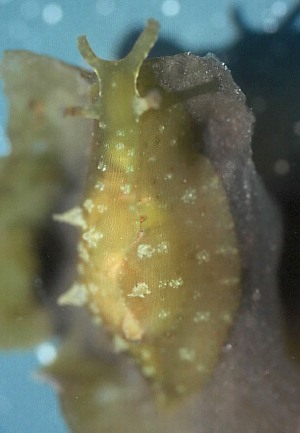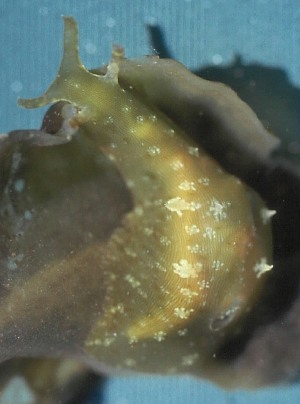

Phyllaplysia padinae
Williams & Gosliner, 1973
Order: ANASPIDEA
Superfamily: APLYSIOIDEA
Family: Aplysiidae
DISTRIBUTION
Known only from the Gulf of California
PHOTO
Punta la Gringa, Bahia de Los Angeles in the Gulf of California, 31 May 2001. In brown alga Hydroclathrus clathratus. Photo: J. Goddard.
Phyllaplysia padinae was described as being olive-green to brownish green with random white spotting on the dorsal surface. No mention was made of the fine longitudinal lines seen in these photos. Some individuals at scattered brown mottling, and some had a few variably shaped papillae, some single, some with multiple tips. The rhinophores are short with noticeably enlarged tips. Williams & Gosliner also describe its characteristic crawling behaviour which consists of extending the anterior end forward, then anchoring it while the mid region is raised from the ground, pulling the posterior third forward. Then the posterior section is anchored while the anterior section is pushed forward. It was rewported to feed by scraping over the blade of the brown algae Padina durvillae ingesting the diatom layer and the outer layer of the alga. Grows to at least 45mm in length.
References:
• Williams, G. C. & T. M. Gosliner. (1973) A new species of anaspidean opisthobranch from the Gulf of California. The Veliger, 16: 216-232.
Rudman, W.B., 2002 (July 1) Phyllaplysia padinae Williams & Gosliner, 1973. [In] Sea Slug Forum. Australian Museum, Sydney. Available from http://www.seaslugforum.net/find/phylpadi
Related messages
Phyllaplysia padinae from the Pacific coast of Mexico
December 3, 2009
From: Kevin Lee


These are prime examples of cryptic slugs that were nearly impossible to "see" on the plants they resided on, as the color matched perfectly. Amazing how Alicia Hermosillo found these guys.
Locality: Los Arcos, Puerto Vallarta, 25fsw, Mexico, East Pacific, 04 July 2009, Rocky & sandy reef, on uw plants. Length: 1/2 inch. Photographer: Kevin Lee.
K:-)
diverkevin@gmail.com
Lee, K., 2009 (Dec 3) Phyllaplysia padinae from the Pacific coast of Mexico. [Message in] Sea Slug Forum. Australian Museum, Sydney. Available from http://www.seaslugforum.net/find/22902
Dear Kevin,
Most species of Phyllaplysia seem to be remarkably well-camouflaged. I have included a copy of your upper photo with labels to show the external sperm groove [gg] which runs from the genital opening [go] to the opening of the pocket in which the penis is retracted when not in operation [po], just below the right eye.
Best wishes,
Bill Rudman
Phyllaplysia padinae from the Gulf of California
July 3, 2002
From: Jeff Goddard


Hi Bill,
At first glance, I thought that Alicia Hermosillo's photos of Petalifera? sp. from Bahia de Banderas might be Phyllaplysia padinae Williams & Gosliner 1973, to my knowledge known only from the Gulf of California. However, her specimen has papillate cephalic tentacles and more highly branched dorsal papillae. Also, the rhinophores appear to be different from the club-shaped rhinophores of P. padinae.
Anyway, for comparison, here are some photos of Phyllaplysia padinae and its flat egg masses that my wife Lise and I found at Punta la Gringa, Bahia de Los Angeles in the Gulf of California on 31 May 2001. We found these specimens inside basketball size specimens of the brown alga Hydroclathrus clathratus at the water's edge on a cobble beach at low tide. The slugs later grazed on pieces of this alga in the lab. Williams & Gosliner (1973) named P. padinae after Padina durvillaei, the substrate they most commonly observed the slug on, and on which P. padinae feeds. They also reported finding it on Zostera sp.
References:
• Williams, G. C. & T. M. Gosliner. (1973) A new species of anaspidean opisthobranch from the Gulf of California. The Veliger, 16: 216-232.
Best wishes,
Jeff
goddard@lifesci.ucsb.edu
Goddard, J., 2002 (Jul 3) Phyllaplysia padinae from the Gulf of California. [Message in] Sea Slug Forum. Australian Museum, Sydney. Available from http://www.seaslugforum.net/find/7395Thanks Jeff,
The Phyllaplysia - Petalifera group of species are very confusing so it is good to get photos of some of them for comparative purposes. I have put your photos of the egg ribbons in a separate message.
Best wishes,
Bill Rudman
Egg ribbon of Phyllaplysia padinae
July 3, 2002
From: Jeff Goddard


Hi Bill,
To accompany my message on Phyllaplysia padinae, here is a photo of its egg ribbon, also taken at Punta la Gringa, Bahia de Los Angeles in the Gulf of California on 31 May 2001.
Best wishes,
Jeff
goddard@lifesci.ucsb.edu
Goddard, J., 2002 (Jul 3) Egg ribbon of Phyllaplysia padinae. [Message in] Sea Slug Forum. Australian Museum, Sydney. Available from http://www.seaslugforum.net/find/7420Thanks Jeff,
This egg ribbon is similar to that of Dolabrifera, and quite different from that found in species of Aplysia in which the egg string forms a tangled mass.
Best wishes,
Bill Rudman
